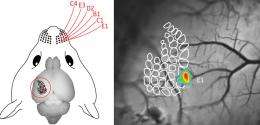New powerful tool can visualize dynamic activity of electrical signals in neuronal populations

Information processing in the brain relies on the coordinated activity between populations of different types of neurons, each with distinct electrical properties and connections. Understanding how complex neuronal circuitry processes information is challenging, as it requires measuring the activity of groups of specified cells.
Thomas Knopfel of the RIKEN Brain Science Institute, Wako, Japan, and his colleagues have developed a genetically encoded voltage sensor that can be used to probe the electrical of activity from selected populations of defined neurons within the brains of living animals. The sensor is based on voltage-sensitive proteins that insert themselves into the membrane of genetically targeted nerve cells and emit a fluorescent signal in response to the changes in membrane voltage that occur during neuronal activity.
Knopfel’s group validated the sensor by introducing it into cultured mouse hippocampal neurons. By inserting electrodes into the cells and observing them under the microscope, they found that single spontaneous nervous impulses were accompanied by an increase in yellow fluorescence.
The same results were obtained in brain slices prepared from mice transfected with DNA encoding the sensor while still in the womb. These experiments also showed that the sensor is capable of detecting circuit activity in the slices. When nervous impulses were induced in specified cells using electrodes, fluorescent signals were observed in the cells connected to them.
Finally, the researchers demonstrated that the sensor can detect the activity of specific groups of cells in the brains of live mice in response to natural sensory stimuli. Again, they transfected embryonic mice with the sensor, targeting a brain region called the barrel cortex, which receives information from the whiskers.
When the mice became adults, the researchers stimulated their whiskers and monitored activity in the barrel cortex through thinned regions of the animals’ skulls. Deflection of individual whiskers was found to produce fluorescent signals in the corresponding area of the cortex.
Other optical methods available for monitoring neuronal activity have disadvantages. Voltage-sensitive dyes can be toxic to cells, while genetically encoded calcium indicators, which fluoresce in response to the localized calcium signals characteristic of neuronal activity, can interfere with signaling pathways by buffering calcium and provide information only on a slower time scale. The voltage sensor developed by Knöpfel and his colleagues therefore improves on them.
“This will facilitate the investigation of fundamental questions of information processing in the brain,” says Knöpfel, “and will also be applicable to directly visualize cognitive function.”
More information: Akemann, W., et al, Imaging brain electric signals with genetically targeted voltage-sensitive fluorescent proteins. Nature Methods 7, 643-649 (2010).

















